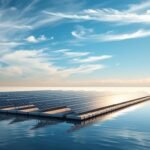Imagine turning unused water surfaces into clean electricity generators. That’s exactly what floating solar technology accomplishes. These innovative systems place solar panels on reservoirs, lakes, and ponds instead of using valuable land.
This approach represents a brilliant solution for urban areas with limited space. It’s gaining momentum across the renewable energy sector worldwide. Countries in Asia and Europe are already leading this exciting development.
The United States holds tremendous opportunity for growth. A National Renewable Energy Laboratory study reveals fascinating data. Federally owned reservoirs could generate enough electricity to power approximately 100 million homes annually.
Beyond producing clean power, these installations offer additional benefits. They reduce water evaporation from reservoirs and improve panel efficiency through natural cooling. This technology represents a smart dual-use of existing water bodies.
Key Takeaways
- Floating solar panels install on water surfaces instead of land
- This technology helps solve space limitations in urban areas
- These systems generate clean electricity while reducing water evaporation
- Natural water cooling improves solar panel efficiency
- The United States has significant untapped potential for this technology
- Global adoption is growing, with Asia and Europe leading implementation
- Combines energy production with water conservation benefits
What Are Floating Solar Farms and Why They Matter
Have you ever seen solar panels floating on water? These innovative systems turn lakes and reservoirs into clean energy generators. They’re called floatovoltaics, and they’re changing how we think about renewable power.
Defining Floatovoltaics: Solar Panels That Work on Water
Floatovoltaics are special solar panel arrays designed for water installation. They mount on buoyant structures anchored to the bottom or shoreline. This approach uses water surfaces that would otherwise sit unused.
These systems work just like land-based panels but with extra benefits. Water naturally cools the equipment, boosting performance. The setup also helps conserve precious land resources.
The Growing Importance of Space-Efficient Renewable Energy
Urban areas face serious space constraints for energy projects. Floatovoltaics offer a smart solution by utilizing existing water bodies. This technology maximizes energy production without consuming additional land.
Research shows incredible potential for this approach. Federally managed reservoirs in the United States could generate massive amounts of clean electricity. This could power millions of homes while conserving water through reduced evaporation.
Countries in Asia and Europe already deploy large-scale floating solar projects. The United States is now exploring this technology more seriously. It represents a crucial step toward sustainable, space-efficient power generation.
These installations support carbon reduction goals while addressing land use challenges. They demonstrate how innovation can create multiple benefits from single solutions. Water-based solar technology represents the future of smart energy planning.
How Floating Solar Technology Actually Works
Ever wonder how solar panels stay afloat while generating clean electricity? These innovative systems combine marine engineering with renewable energy technology. They transform still water surfaces into active power plants.

The Engineering Behind Water-Based Solar Systems
Special flotation devices keep photovoltaic panels above water. Most installations use High-Density Polyethylene plastic floats. These materials resist corrosion and withstand harsh weather conditions.
Manufacturers design these structures for maximum stability. They arrange panels in arrays that float like giant rafts. The configuration allows easy access for maintenance crews.
All electrical components receive waterproof protection. Inverters and transformers often mount on separate floating platforms. This prevents water damage to sensitive equipment.
Anchoring and Grid Connection Challenges
Secure anchoring proves crucial for system longevity. Engineers use multiple attachment points to the reservoir bed. These connections withstand strong currents and wind forces.
Grid interconnection presents unique obstacles. Underwater cables carry electricity to shore stations. These specialized cables require protective conduits and regular inspections.
Distance affects transmission efficiency significantly. Longer cable runs mean greater energy loss. Projects need careful planning to minimize this impact.
“The cooling effect from water can improve panel efficiency by up to 15% compared to land-based systems.”
The Cooling Effect That Boosts Efficiency
Water naturally cools solar panels during operation. This temperature regulation prevents overheating issues. Cooler panels convert sunlight more effectively into electricity.
Real-world data demonstrates this advantage clearly. Thailand’s Sirindhorn Dam installation shows impressive results. Their floating array outperforms nearby ground-mounted systems consistently.
This efficiency boost means more power generation. You get greater energy output from the same number of panels. It’s like getting extra capacity without additional equipment.
Maintenance becomes easier with natural cleaning. Water spray helps keep surfaces free from dust. This contributes to sustained high performance over time.
Remarkable Advantages of Choosing Floating Solar
What if you could generate clean electricity while keeping land available for other uses? Floating solar technology delivers exactly that. These innovative systems offer multiple benefits beyond basic power generation.
Dual Land Usage: Generating Power Without Using valuable Land
You get electricity production without sacrificing precious land resources. These installations use water surfaces that already exist. Your community can maintain reservoirs for water storage while generating power simultaneously.
This approach preserves land for agriculture, housing, or natural habitats. It’s particularly valuable in urban areas where space is limited. You achieve energy goals without additional land consumption.
Water Conservation Through Reduced Evaporation
Floating panels create shade over water surfaces. This shading significantly reduces evaporation rates. You help conserve millions of gallons annually through this simple mechanism.
Data from operational installations shows impressive results. Some projects save enough water to supply thousands of households. This benefit proves especially crucial during drought conditions.
Natural Cooling for Enhanced Energy Production
Water provides natural cooling for photovoltaic equipment. This temperature regulation boosts performance substantially. You can achieve up to 15% higher efficiency compared to ground-mounted systems.
Cooler panels operate more effectively throughout the day. They maintain optimal performance even during peak sunlight hours. You get more energy from the same equipment investment.
“The natural cooling effect from water bodies consistently improves panel output, making floating systems more productive than their land-based counterparts.”
Flood Resilience and Adaptability
These systems rise and fall with changing water levels. You avoid damage during flood events that would destroy fixed installations. The technology adapts to environmental conditions rather than fighting them.
This resilience ensures consistent power production during weather extremes. Your energy supply remains reliable when communities need it most. The floating design handles water level variations gracefully.
Combined benefits make this approach exceptionally practical. You address multiple challenges with a single solution. It represents smart technology working with nature rather than against it.
Addressing the Challenges and Limitations
While floating solar technology offers exciting benefits, it’s important to understand the hurdles that come with innovation. Every new energy solution faces obstacles, and water-based systems present unique considerations.
These challenges range from financial investments to technical complexities. Understanding them helps communities make informed decisions about renewable energy options.

Higher Initial Costs and Investment Considerations
Setting up these systems requires specialized equipment that increases upfront costs. You need floating platforms, anchors, and waterproof cables. These components cost more than traditional ground-mounted racking systems.
However, long-term efficiency gains can help balance these initial investments. Cooler panels generate more electricity over their lifespan. This increased output can improve the overall financial return.
Project financing often requires creative approaches. Investors may need reassurance about technology reliability. Detailed feasibility studies help demonstrate the economic viability.
Grid Interconnection Complexities
Connecting water-based systems to the electrical grid presents unique challenges. Underwater cables must carry generated power to shore stations. These installations require specialized engineering and safety features.
Distance affects transmission efficiency significantly. Longer cable runs mean greater energy loss during transmission. Careful planning minimizes this impact through optimal placement.
Additional power management devices ensure stable electricity delivery. These components protect the grid from fluctuations. They represent an important part of the overall system cost.
Environmental Impact and Longevity Questions
Researchers continue studying how these installations affect aquatic ecosystems. Water quality monitoring helps understand any changes. Proper design minimizes disturbance to natural habitats.
The technology’s longevity remains somewhat unproven. Limited data exists about decades-long performance in water environments. Manufacturers continue improving materials for better durability.
Weather exposure and water conditions test equipment resilience. Regular maintenance ensures continued operation. Ongoing innovation addresses these concerns through improved designs.
“While floating solar presents higher initial costs, the combination of reduced evaporation and increased efficiency creates compelling long-term value that often justifies the investment.”
Regulatory hurdles and transmission availability can limit development. Even areas with excellent technical potential face these barriers. Local policies and infrastructure play crucial roles in project success.
Continuous innovation and investment will help overcome these limitations. As technology matures, costs will likely decrease while reliability improves. These advancements will make floating solar an increasingly attractive option.
Understanding both promises and pitfalls creates realistic expectations. Addressing challenges thoughtfully ensures sustainable growth. This balanced approach supports widespread adoption of this promising technology.
Global Success Stories and US Potential
While America watches from the sidelines, Asian countries are building enormous water-based solar arrays. These massive installations demonstrate what’s possible when innovation meets ambitious renewable energy goals. The scale of these projects will likely surprise you.
World’s Largest Floating Solar Projects: Asia Leading the Way
China dominates this technology with record-breaking installations. Their 320MW Dezhou Dingzhuang farm represents engineering marvel. This massive project generates enough electricity for thousands of homes.
The Three Gorges project follows at 150MW capacity. It floats on the same reservoir as the famous hydroelectric dam. This creates a powerful hybrid energy system.
Other Asian nations show impressive commitment too. Singapore’s 60MW Sembcorp farm maximizes limited space. Thailand’s 45MW Sirindhorn Dam installation sets regional standards.
These projects prove the technology works at utility scale. They provide clean power while conserving water through reduced evaporation. The success stories inspire global adoption.
America’s Untapped Reservoir Potential
Your country holds incredible opportunity for growth. Federally owned reservoirs could host massive solar arrays. Research shows they could generate 1,476 TWh yearly.
This represents enough electricity to power millions of American homes. The numbers come from detailed National Renewable Energy Laboratory studies. They identify specific states with highest capacity.
Texas leads in potential among all states. California and Oklahoma follow closely behind. These areas have ideal conditions for rapid development.
Current projects seem small compared to Asian examples. New Jersey’s 8.9MW plant shows what’s possible today. The gap between current and potential capacity highlights opportunity.
Why the US is Poised for Floating Solar Growth
Existing hydropower infrastructure creates perfect pairing opportunities. You can combine solar with hydroelectric plants seamlessly. This hybrid approach enhances grid reliability.
During drought conditions, these systems provide backup power. They utilize existing transmission infrastructure too. This reduces development costs significantly.
Policy support continues growing across the country. Technological advancements make installations more efficient. Investment interest increases as success stories multiply.
Your nation’s innovation potential positions it for leadership. While starting behind Asian countries, the growth trajectory looks promising. The combination of resources and technology creates perfect conditions.
“The integration of floating solar with existing hydropower infrastructure represents one of the most promising avenues for renewable energy growth in the United States, leveraging both technologies’ strengths while minimizing new land use.”
Water bodies across America await development. The technology proves itself daily in international projects. Your country stands ready to join this renewable revolution.
With proper investment and policy support, growth could accelerate quickly. The potential exists for catching up with global leaders. The future looks bright for American floating solar development.
Conclusion: The Bright Future of Floating Solar Energy
Picture this: clean electricity generation that saves land while boosting efficiency. That’s what innovative water-based systems deliver. These projects transform reservoirs and lakes into active power plants.
Global capacity is projected to exceed 5GW by 2025. This growth demonstrates increasing adoption worldwide. Your country can harness this momentum for sustainable development.
Covering just 10% of global water bodies could generate massive electricity. This equals four times the United Kingdom’s annual consumption. The scalability proves truly remarkable.
Integration with existing hydropower creates perfect synergy. You get reliable renewable energy without new land use. This approach supports carbon reduction goals effectively.
Continued research and investment will unlock full capabilities. Supportive policies accelerate deployment across your nation. The future looks bright for this transformative technology.
You now understand how these systems contribute to energy independence. They represent smart solutions for tomorrow’s power needs. Embrace this technology as part of our sustainable future.









